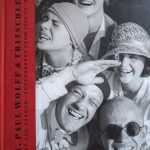The New Frankfurt project under the architect Ernst May Besuchen Sie die schöne Stadt Visit the Beautiful City of Frankfurt am Main Musik im Leben der Völker Englert & Schlosser
The New Frankfurt / Das Neue Frankfurt project ran from 1925 until 1930 under the direction of architect Ernst May. More than 20 housing developments were planned between 1926 and 1930 – comprising around 15,000 homes in total. Paul Wolff joined May’s team after meeting the latter through – presumably – the art historian Fried Lübbecke.
The New Frankfurt project under the architect Ernst May
Dr. Paul Wolff & Tritschler. Light and Shadow – Photographs from 1920 to 1950. © 2019 Kehrer Verlag Heidelberg Berlin, authors, artists and photographers [and translator]. ISBN 978-3-86828-881-0
Published at Kehrer Verlag. Editor Hans-Michael Koetzle. Translator Alexandra Cox. The respective word count in the book is indicated for each essay (for reasons of concision, I omit the endnotes, but they are included in the word count).
From: Photographer of Old and New Frankfurt.
The New Frankfurt project under the architect Ernst May
Paul Wolff between Convention and Avant-Garde.
by Sabine Hock. Translated from German by Alexandra Cox.
9,896 words
 The New Frankfurt: on the New Frankfurt project under the architect Ernst May Englert & Schlosser
The New Frankfurt: on the New Frankfurt project under the architect Ernst May Englert & Schlosser
The architect Ernst May (1886-1970) had joined the office [Office of Economic Affairs] as director of urban development on September 1, 1925. During his period of only five years there (through 10.1.1930), he created the “New Frankfurt”. On the basis of a residential construction program passed by the City Council, May and his staff planned and built more than 20 housing developments between 1926 and 1930, comprising approximately 15,000 homes in total. In order to advertise the comprehensive concept, which incorporated all areas of modern life in a major city, under the motto, “Building for a new life”, an effective press and public relations system was developed, which the employees—often personally recruited by May—put into practice at the relevant municipal departments. For example, a “Graphics Office” was in existence at the municipal construction department from the early date of 1925, led by the graphic designer Hans Leistikow (1892–1962). Among Leistikow’s responsibilities was the design of the programmatic magazine Das Neue Frankfurt (The New Frankfurt), which May founded in 1926 and subsequently published in partnership with Fritz Wichert (1878–1951), the director of the municipal arts and craft school. The New Frankfurt project under the architect Ernst May
We have no surviving record of how Paul Wolff came to join Ernst May’s team. However, the connection could have been made via Fried Lübbecke, of all people, the representative of Old Frankfurt and hence May’s severest antagonist. At the department for advertising and exhibition organization at the city’s Office of Economic Affairs, Lübbecke played a role in preparing the exhibition, “Music in the Life of the Peoples” [Musik im Leben der Völker] from 1926, which was to run in parallel to the large-scale “A Summer of Music” festival of concerts the subsequent year. In the run-up, the department of advertising and exhibition organization issued a promotional brochure bearing the enticing title Besuchen Sie die schöne Stadt Frankfurt am Main (Visit the Beautiful City of Frankfurt am Main), which made reference to the planned events during the “Summer of Music” from June 11 through August 28, 1927. The photographs in this lavishly illustrated brochure, in particular the 29 current shots from the city, were supplied by Paul Wolff. The New Frankfurt project under the architect Ernst May Musik im Leben der Völker Englert & Schlosser
(…)
The construction department was also responsible for the overall design concept of the “Summer of Music” (including the exhibition architecture), and therefore a link could have been easily drawn between Paul Wolff and the “makers” of the New Frankfurt via the municipal promotional brochure. A further personal relationship between Alt-Frankfurt and Neues Frankfurt was represented by the publisher Georg Schlosser (1871–1943), who published the three books by Wolff/Lübbecke, as well as the magazine by May’s team, at his publishing house Englert & Schlosser.
(…) (…)
Dr. Paul Wolff acquired his first Leica camera in 1926. From Aus zoologischen Gärten (1929) and other books in Die Blauen Bücher series, through Formen des Lebens (1931), Wolff’s Leica-related publishing activity culminated in Meine Erfahrungen mit der Leica in 1934. Click on the poppy below to read a brief passage about this from:
Dr. Paul Wolff & Tritschler. Light and Shadow. Publisher Kehrer Verlag. Editor Hans-Michael Koetzle. Translator Alexandra Cox
